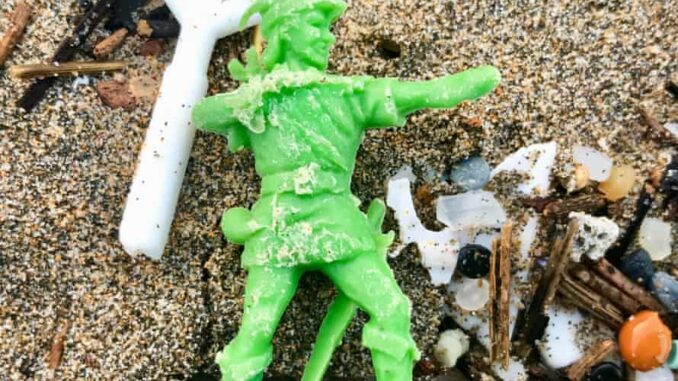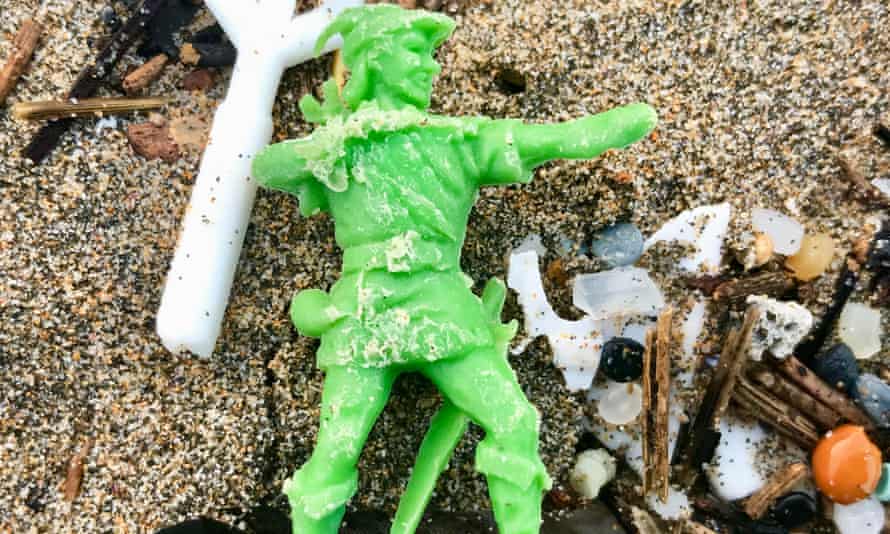
An artist’s images of tiny toys and figurines dumped in the ocean highlight the wasteful ways we have to change
Legoland
Social media was made for projects like Tracey Williams’s #LegoLostatSea, which anecdotally charts the plastic that has been dumped in the ocean in the past 70 years. Williams began her mission after becoming obsessed with the container of 4.8m Lego pieces that spilled from a cargo ship 20 miles off Land’s End in 1997, and which continue to be washed up on Cornwall’s beaches every day. The fact that many of those Lego sets had a nautical theme – mini plastic octupuses and divers’ flippers are common finds – makes them a perfect metaphor for the 8m tonnes of plastic that end up in the oceans each year. At current rates, there will be more plastic than fish in the sea by 2050. A special report in the journal Science last week launched a campaign for governments to commit to phase out “virgin” plastic production in the next 20 years. Even if that happens, our age will be known for centuries to come for its detritus: the Happy Meal figurines and plastic bottles and Lego snorkellers that come and go on every tide.
Graveyard shift

Most days I walk down the lane which runs between the two halves of Highgate cemetery in north London, resting place of Karl Marx and Jeremy Beadle. The rows of Victorian monuments and tombs in the less visited parts of the graveyard are fabulously overgrown with ivy and wild flowers, and quite thickly wooded, a sight that never fails to conjure, in me at least, a sense of natural renewal and a welcome jolt of seize-the-day purpose. A new 25-year sustainability plan for the graveyard involves the removal of many trees, opening up views of the Shard and St Paul’s Cathedral. “Romantic decay is attractive but also destructive,” the cemetery’s chief executive, Ian Dungavell, said. His longer-term tenants are not part of the consultation process.
Blowing smoke

I never hear George Galloway’s self-aggrandising polemics without remembering watching the Observer’s late, renowned photographer Jane Bown take his portrait many years ago. Jane, then in her 80s, carried her camera in a wicker shopping bag, had no lights, and kept up a running commentary – often fabulously blunt – as she worked. Galloway, a man not lacking in vanity, was disarmed first by her opening remark: “Oh dear, what on earth are we going to do with that face?” Her muttered despair only deepened as Jane looked in vain for an angle that might be at all serviceable. “That face is no good at all.” Eventually, she had Galloway lying on the floor, blowing smoke into the air from a fat cigar. “There,” she said, finally, with relief. “That’s it, there you are. That’s you.”
Jack of hearts

I’m not claiming powers of prophecy but just over 12 months ago I sent an email – an embarrassingly heartfelt pitch – to Jonathan Barnett, agent of the footballer Jack Grealish. In it, I set out an idea for a book about the coming year in Grealish’s life, in which, I suggested, he would “become the most charismatic and talked-about talent in the English game since Gazza”. Grealish had not yet made his international debut, but this would be the inside story of how he became a semi-mythical national talisman. I may have quoted something from The Tempest. Barnett sent me a brief note back saying, “I think it’s too early for a book about Jack.” Watching Grealish deftly help to dismantle Germany on Tuesday, it was hard not to feel in England’s victory, literature’s loss.
- Tim Adams in an Observer columnist


Be the first to comment